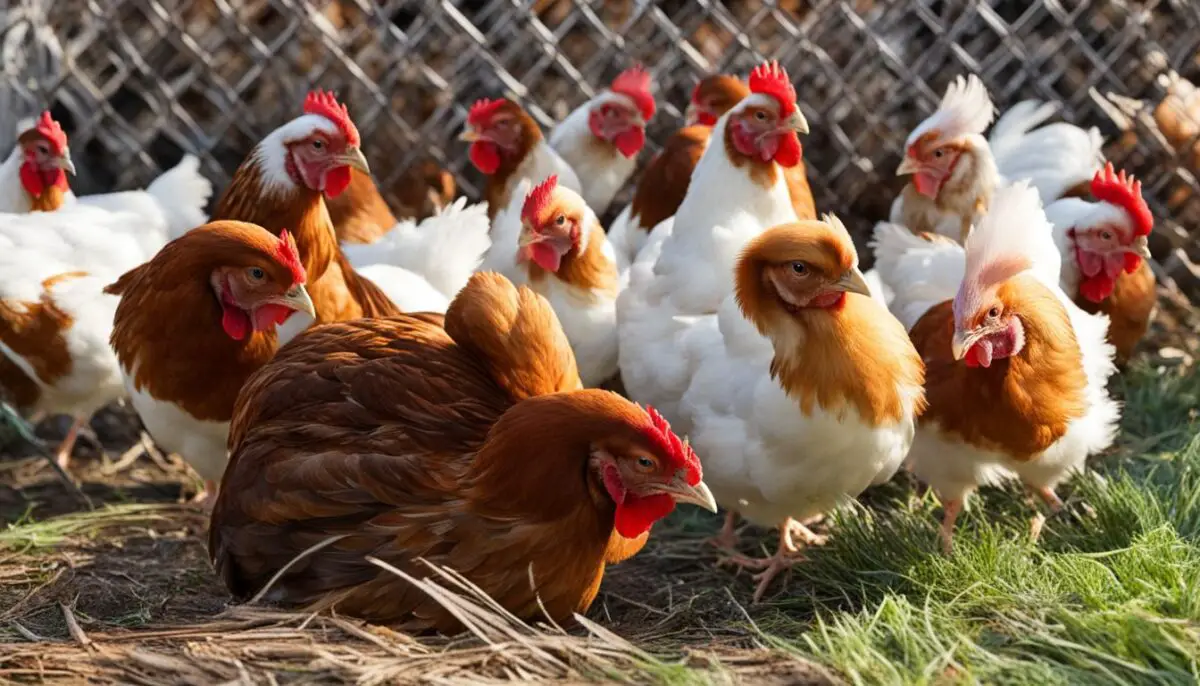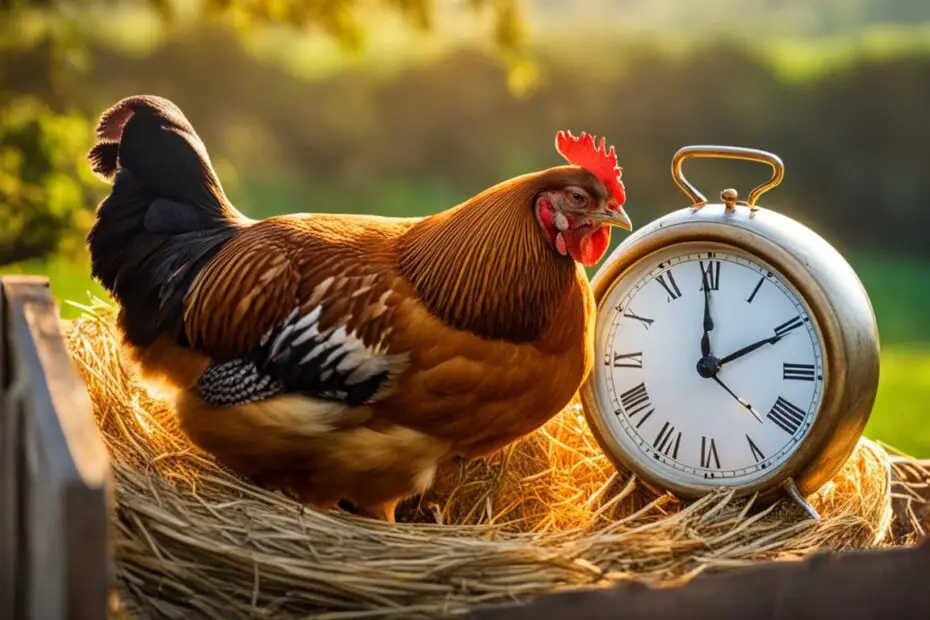Chickens have a mysterious and secretive laying habit, making it difficult to determine at what times they lay eggs. However, understanding the egg laying process can provide some insight into the timing.
After receiving a light cue from the sun, a chicken releases an egg from its ovary into the uterus. The egg slowly fills up with egg white, and a membrane forms around the uterus. It takes about 26 hours for the egg to be fully formed in the uterus, and once the egg is ready, the chicken’s uterus contracts and releases the egg. The whole process starts again about an hour after the egg is laid.
Most chickens tend to lay their eggs early in the morning within the first 6 hours after sunrise, but there are exceptions, with some chickens laying as late as 3 PM. It’s important to note that chickens do not lay eggs at night.
Knowing the timing of egg laying in chickens can be beneficial for chicken owners. Collecting eggs shortly after they are laid can prevent egg-eating and broody behavior in hens. It can also help identify if there are any secret laying spots in the coop. While there are no guarantees, creating a comfortable and safe environment for chickens can encourage optimal egg production.
Key Takeaways:
- Chickens lay eggs early in the morning, within the first 6 hours after sunrise.
- Some chickens may lay eggs as late as 3 PM.
- Chickens do not lay eggs at night.
- Collecting eggs shortly after they are laid can prevent undesirable behaviors in hens.
- Creating a comfortable and safe environment can encourage optimal egg production.
Factors Affecting Egg Laying in Chickens
Several factors can impact the timing of egg laying in chickens. Understanding these factors can help chicken owners optimize egg production. Here are some key factors to consider:
- Age of hens: Most hens start laying eggs between 20 and 24 weeks old. The age at which chickens begin laying can vary depending on the breed and individual characteristics.
- Breed of chickens: Different chicken breeds have different egg-laying patterns. Some breeds start laying eggs at around 20 weeks old, while others may take up to 28 weeks.
- Hormone levels: Hormones play a crucial role in regulating the egg-laying process. Fluctuations in hormone levels can affect the timing and frequency of egg laying.
- Health of hens: Healthy hens are more likely to lay eggs regularly. Good nutrition, proper veterinary care, and disease prevention measures are essential for maintaining the health of chickens.
- Lighting conditions: Chickens require a minimum of 14 hours of daylight to lay eggs consistently. During periods of reduced daylight, such as winter, egg production may decrease or even stop.
- Temperature: Extreme temperatures, both high and low, can disrupt the egg-laying process. Chickens prefer moderate temperatures for optimal egg production.
- Stress levels: Stress can have a negative impact on egg laying in chickens. Environmental stressors, such as noise or predator presence, as well as social stressors, like overcrowding, can affect egg production.
- Diet: Nutrition is vital for proper egg production. A balanced diet that includes sufficient protein and a calcium source for strong eggshells is essential.

In summary, multiple factors contribute to egg laying in chickens, including the age and breed of the hens, hormone levels, health, lighting conditions, temperature, stress levels, and diet. By considering and addressing these factors, chicken owners can create an environment conducive to optimal egg production.
Signs of Approaching Egg Laying
Before chickens start laying eggs, there are several physical and behavioral changes that can indicate that they are approaching egg laying. These signs are essential for chicken owners to recognize as they prepare for the exciting arrival of fresh eggs.
Physical Changes in Hens
As hens get closer to laying their first eggs, they undergo noticeable physical transformations. One of the key changes is their combs and wattles swelling and turning a deep red color. These vibrant displays indicate that the hens are reaching maturity and are preparing for egg production. Additionally, their feathers are clean and well-groomed, showcasing their readiness to become productive layers.
Behavioral Changes in Hens
Hens exhibit distinct behavioral changes when they are about to start laying eggs. One telltale sign is the separation of their pelvis bones, which can be felt slightly below their vent. This separation is a physiological adaptation that allows the passage of eggs through the reproductive system. Another behavioral change to look out for is the submissive squat. Hens will perform this behavior by stopping, squatting, and slightly extending their wings for balance. The submissive squat indicates that the hens will start laying eggs within a week.
Increased Interest in Nesting Boxes
As hens near the onset of egg laying, they become increasingly curious about nesting boxes. They may spend more time investigating and testing various nesting spots, displaying their excitement and preparation for egg-laying. This heightened interest in nesting boxes is a clear sign that the hens will soon begin utilizing them to lay their eggs.
To help you visualize these signs, here is a visual representation:
| Sign | Description |
|---|---|
| Physical Changes | Swelling and deep red color in combs and wattles |
| Behavioral Changes | Separation of pelvis bones and performing the submissive squat |
| Increased Interest | Spending time in nesting boxes |

These signs serve as valuable indicators of the approaching egg-laying phase. By paying attention to these changes, chicken owners can prepare an optimal environment for their hens, ensuring a smooth transition into egg production.
Preparation for Egg Laying
Getting ready for egg laying requires proper preparation to ensure the comfort and productivity of your chickens. Here are some essential steps to take:
Nesting Box Set Up
Creating a suitable nesting box is crucial for your hens to feel secure and comfortable while laying eggs. Provide one nesting box for every four chickens. Line the boxes with soft nesting pads or liners and cover them with straw or pine shavings for added coziness. It’s important to keep the nesting box in a quiet and dark area to give your hens the privacy they need.
Providing Clean and Fresh Water
Chickens require clean and fresh water for proper egg production. Make sure to provide a constant supply of clean water to keep your hens hydrated. Eggs are composed of 75% water, so maintaining good hydration is essential for their quality and quantity of eggs produced.
Artificial Lighting to Stimulate Egg Production
Using artificial lighting can help stimulate egg production, especially during the darker months when natural daylight hours may be limited. The amount of lighting needed depends on the age and bodyweight of your hens. Consult a poultry specialist to determine the optimal lighting conditions for your flock.
Starting on Layer Feeds
Once your chickens start laying eggs, it’s crucial to switch them to a specialized layer feed. Layer feeds contain less protein and higher levels of calcium, which is necessary for the production of strong eggshells. Make sure to provide a balanced and nutritious diet to support your hens’ overall health and egg-laying capabilities.
Providing Oyster Shells for Extra Calcium
To ensure your hens receive an adequate supply of calcium for their eggshells, consider providing them with oyster shells in a separate dish. Oyster shells are a valuable source of additional calcium, which can help prevent calcium deficiencies in your hens and promote the development of strong and healthy eggs.
By taking these steps to prepare for egg laying, you can create a conducive environment for your chickens and enhance their egg production potential. Providing the right nesting conditions, access to clean water, appropriate lighting, and a balanced diet will help ensure a bountiful supply of fresh and nutritious eggs from your flock.
Conclusion
Understanding the timing of egg laying in chickens is essential for maximizing egg production. While most chickens typically lay eggs early in the morning, individual variations can occur. Factors such as age, breed, hormones, health, lighting conditions, temperature, stress levels, and diet all play a role in determining when chickens will start laying eggs. By providing a comfortable and safe environment, ensuring access to clean water, and feeding a balanced diet, chicken owners can encourage optimal egg production.
Knowing when chickens are laying eggs brings several benefits. It can help prevent undesirable behaviors like egg eating and broodiness. Additionally, identifying the eggs shortly after they are laid can prevent hens from becoming broody and encourage more regular egg laying. Monitoring the nesting boxes also allows owners to discover any secret laying spots. Being aware of the egg laying schedule is crucial for maintaining a productive egg-laying flock.
Creating an optimal environment for chickens is key to their overall well-being and productivity. Providing a comfortable and safe coop, clean water, and a balanced diet with sufficient calcium for strong eggshells will contribute to healthy and consistent egg production. Understanding the importance of timing and environment will result in a bountiful supply of fresh eggs for chicken owners to enjoy.
FAQ
What time of day do chickens lay eggs?
Most chickens tend to lay their eggs early in the morning within the first 6 hours after sunrise. However, individual variations can occur, with some chickens laying as late as 3 PM.
When do hens lay their eggs?
Hens start laying eggs between 20 and 24 weeks old. The timing can also depend on the breed of chickens, with some starting at 20 weeks while others may take up to 28 weeks.
What factors affect the timing of egg laying in chickens?
Several factors can affect the timing of egg laying, including the age of hens, breed of chickens, hormone levels, health of hens, lighting conditions, temperature, stress levels, and diet.
What are the signs of approaching egg laying in chickens?
Signs of approaching egg laying include physical changes in hens such as fully grown feathers, swelling and color changes in combs and wattles, and separation of the pelvis bones. Behavioral changes include increased interest in nesting boxes and spending time inside them to test them out.
How should I prepare for egg laying?
To prepare for egg laying, set up suitable nesting boxes for your chickens, provide clean and fresh water, consider using artificial lighting to stimulate egg production, switch to layer feeds for balanced nutrition, and provide oyster shells for extra calcium if needed.
What are the benefits of knowing when chickens are laying eggs?
Knowing the timing of egg laying in chickens can help prevent undesirable behaviors like egg eating and broodiness. It also allows you to collect eggs shortly after they are laid and monitor the nesting boxes for any secret laying spots.

